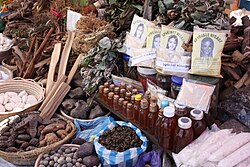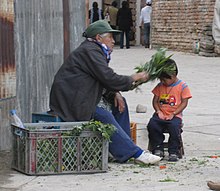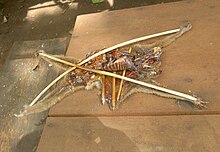Traditional medicine


| This article is part ofa serieson |
| Alternative medicine |
|---|
 |
Traditional medicine(also known asindigenous medicineorfolk medicine) comprises medical aspects oftraditional knowledgethat developed over generations within thefolk beliefsof various societies, includingindigenous peoples,before the era of modernmedicine.TheWorld Health Organization(WHO) defines traditional medicine as "the sum total of the knowledge, skills, and practices based on the theories, beliefs, and experiences indigenous to different cultures, whether explicable or not, used in the maintenance of health as well as in the prevention, diagnosis, improvement and treatment of physical and mental illness".[1]Traditional medicine is often contrasted withEvidence based medicine.
In someAsianandAfricancountries, up to 80% of the population relies on traditional medicine for theirprimary health careneeds. Traditional medicine is a form ofalternative medicine.Practices known as traditional medicines includetraditional European medicine[citation needed],traditional Chinese medicine,traditional Korean medicine,traditional African medicine,Ayurveda,Siddha medicine,Unani,ancient Iranian medicine,traditional Iranian medicine,medieval Islamic medicine,Muti,IfáandRongoā.Scientific disciplines that study traditional medicine includeherbalism,ethnomedicine,ethnobotany,andmedical anthropology.
The WHO notes, however, that "inappropriate use of traditional medicines or practices can have negative or dangerous effects" and that "further research is neededto ascertain the efficacy and safety "of such practices andmedicinal plantsused by traditional medicine systems.[1]Its "Traditional Medicine Strategy 2014–2023" said that the WHO would "support Member States in developing proactive policies and implementing action plans that will strengthen the role traditional medicine plays in keeping populations healthy."[2]
Usage and history
[edit]Classical history
[edit]In the written record, the study of herbs dates back 5,000 years to the ancientSumerians,who described well-established medicinal uses for plants. InAncient Egyptian medicine,theEbers papyrusfrom c. 1552 BC records a list of folk remedies and magical medical practices.[3]TheOld Testamentalso mentions herb use and cultivation in regards toKashrut.
Many herbs and minerals used inAyurvedawere described by ancient Indian herbalists such asCharakaandSushrutaduring the 1st millennium BC.[4]The firstChinese herbalbook was theShennong Bencaojing,compiled during theHan dynastybut dating back to a much earlier date, which was later augmented as theYao xing Lun(Treatise on the Nature of Medicinal Herbs) during theTang dynasty.Early recognised Greek compilers of existing and current herbal knowledge includePythagoras and his followers,Hippocrates,Aristotle,Theophrastus,DioscoridesandGalen.
Roman sources includedPliny the Elder'sNatural HistoryandCelsus'sDe Medicina.[5]Pedanius Dioscoridesdrew on and corrected earlier authors for hisDe Materia Medica,adding much new material; the work was translated into several languages, andTurkish,ArabicandHebrewnames were added to it over the centuries.[6]Latin manuscripts ofDe Materia Medicawere combined with a Latin herbal byApuleius Platonicus(Herbarium Apuleii Platonici) and were incorporated into the Anglo-SaxoncodexCotton Vitellius C.III.These early Greek and Roman compilations became the backbone of European medical theory and were translated by the PersianAvicenna(Ibn Sīnā, 980–1037), the PersianRhazes(Rāzi, 865–925) and the JewishMaimonides.[5]
Somefossilshave been used in traditional medicine since antiquity.[7]
Medieval and later
[edit]Arabic indigenous medicine developed from the conflict between the magic-based medicine of theBedouinsand the Arabic translations of the Hellenic andAyurvedicmedical traditions.[8]Spanish medicine was influenced by the Arabs from 711 to 1492.[9]Islamic physicians andMuslim botanistssuch asal-Dinawari[10]andIbn al-Baitar[11]significantly expanded on the earlier knowledge of materia medica. The most famous Persian medical treatise was Avicenna'sThe Canon of Medicine,which was an earlypharmacopoeiaand introducedclinical trials.[12][13][14]TheCanonwastranslated into Latinin the 12th century and remained a medical authority in Europe until the 17th century. TheUnanisystem of traditional medicine is also based on theCanon.[15]
Translations of the early Roman-Greek compilations were made into German byHieronymus Bockwhose herbal, published in 1546, was calledKreuter Buch.The book was translated intoDutchasPemptadesbyRembert Dodoens(1517–1585), and from Dutch intoEnglishbyCarolus Clusius,(1526–1609), published byHenry Lytein 1578 asA Nievve Herball.This becameJohn Gerard's (1545–1612)Herball or General Historie of Plantes.[5][6]Each new work was a compilation of existing texts with new additions.
Women's folk knowledge existed in undocumented parallel with these texts.[5]Forty-four drugs, diluents, flavouring agents andemollientsmentioned by Dioscorides are still listed in the official pharmacopoeias of Europe.[6]ThePuritanstook Gerard's work to theUnited Stateswhere it influenced American Indigenous medicine.[5]
Francisco Hernández,physician toPhilip II of Spainspent the years 1571–1577 gathering information inMexicoand then wroteRerum Medicarum Novae Hispaniae Thesaurus,many versions of which have been published including one byFrancisco Ximénez.Both Hernandez and Ximenez fittedAztecethnomedicinal information into the European concepts of disease such as "warm", "cold", and "moist", but it is not clear that the Aztecs used these categories.[16]Juan de Esteyneffer'sFlorilegio medicinal de todas las enfermedascompiled European texts and added 35 Mexican plants.
Martín de la Cruz wrote a herbal inNahuatlwhich was translated intoLatinbyJuan BadianoasLibellus de Medicinalibus Indorum HerbisorCodex Barberini, Latin 241and given to KingCarlos Vof Spain in 1552.[17]It was apparently written in haste[18]and influenced by the European occupation of the previous 30 years. FrayBernardino de Sahagún's usedethnographicmethods to compile his codices that then became theHistoria General de las Cosas de Nueva España,published in 1793.[17]Castore Durante published hisHerbario Nuovoin 1585 describing medicinal plants from Europe and the East andWest Indies.It was translated into German in 1609 and Italian editions were published for the next century.
Colonial America
[edit]In 17th and 18th-century America, traditional folk healers, frequently women, used herbal remedies,cuppingandleeching.[19]Native Americantraditional herbal medicine introduced cures for malaria, dysentery, scurvy, non-venereal syphilis, and goiter problems.[20]Many of these herbal and folk remedies continued on through the 19th and into the 20th century,[21]with some plant medicines forming the basis for modern pharmacology.[22]
Modern usage
[edit]The prevalence of folk medicine in certain areas of the world varies according to cultural norms.[23]Some modern medicine is based on plantphytochemicalsthat had been used in folk medicine.[24]Researchers state that many of the alternative treatments are "statistically indistinguishable fromplacebo treatments".[25]
Knowledge transmission and creation
[edit]Indigenous medicine is generally transmittedorallythrough a community, family and individuals until "collected". Within a given culture, elements of indigenous medicine knowledge may be diffusely known by many, or may be gathered and applied by those in a specific role of healer such as ashamanormidwife.[26]Three factors legitimize the role of the healer – their own beliefs, the success of their actions and the beliefs of the community.[27]When the claims of indigenous medicine become rejected by a culture, generally three types of adherents still use it – those born and socialized in it who become permanent believers, temporary believers who turn to it in crisis times, and those who only believe in specific aspects, not in all of it.[28][verification needed]
Definition and terminology
[edit]Traditional medicine may sometimes be considered as distinct from folk medicine, and considered to include formalized aspects of folk medicine. Under this definition folk medicine are longstanding remedies and practises passed on and practiced by lay people. Folk medicine consists of thehealingmodalities, ideas of bodyphysiologyandhealthpreservation known to some in a culture, transmitted informally as general knowledge, and practiced or applied by anyone in the culture having prior experience.[29]
Folk medicine
[edit]
Many countries have practices described as folk medicine which may coexist with formalized, science-based, and institutionalized systems of medical practice represented by conventionalmedicine.[30]Examples of folk medicine traditions aretraditional Chinese medicine,Iranian traditional medicine,traditional Korean medicine,Arabic indigenous medicine,Uyghurtraditional medicine, JapaneseKampōmedicine, traditional Aboriginal bush medicine,Native HawaiianLāʻau lapaʻau,andGeorgian folk medicine,among others.[31]
Australian bush medicine
[edit]Generally, bush medicine used byAboriginal and Torres Strait Islander peopleinAustraliais made from plant materials, such as bark, leaves and seeds, although animal products may be used as well.[32]A major component of traditional medicine isherbal medicine,which is the use of natural plant substances to treat or prevent illness.[33]
Native American medicine
[edit]American NativeandAlaska Nativemedicine are traditional forms of healing that have been around for thousands of years. There are manyethnobotanyplants involved in traditional medicine for Native Americans and some are still used today. When it comes to Native American traditional medicine, the ideas surrounding health and illness within the culture are virtually inseparable from the ideas of religion and spirituality.[34]Healers within indigenous communities go by many names ranging frommedicine manor woman to herbalist or even shaman and are considered spiritual or religious leaders within their respective tribes.[34]When it comes to healing, tribal healers would look at a plant's characteristics to determine its efficacy for the treatment of an illness.[35]Specific plant characteristics such as plant shape, smell, color, and taste could aid in determining how the plant could be used as a remedy.[35]The Meskwaki tribe found they could use the juice fromArum maculatumfor snakebites.[35]This was inferred from the milky appearance of the juice from the plant which is said to resemble snake venom, and the plant's shape resembled the head of a snake.[35]Native Americans usedfoxgloveherb as a treatment for an illness they referred to as dropsy or edema, which is fluid buildup typically in the lower legs, and its common cause is heart failure.[35]In modern medicine, foxglove extract is still used under the name digitalis, and its purpose is to moderate the heart rate.[35]Native Americans were successful with some medical practices, such as treating fevers, gastrointestinal conditions, skin rashes, setting bones, as well as birthing babies, and aiding mothers in healing.[35]A study conducted within anIHShospital that allows Navajo healers to visit patients found that the hospital had an 80 percent success rate in getting comatose patients back to consciousness, which is higher than the rate of present-day biomedical management hospitals.[34]The plant familyAsteraceaehas been commonly selected for orthopedic aids and pulmonary aids, specifically the speciesAchilleaandArtemisia.[36]A study conducted amongst 14 different tribes within North America found thatAsteraceaewas the most widely used plant family for its medicinal properties.[36]
Nattuvaidyam
[edit]Nattuvaidyam was a set of indigenous medical practices that existed in India before the advent of allopathic or western medicine.[37]These practices had different sets of principles and ideas of the body, health and disease. There were overlaps and borrowing of ideas, medicinal compounds used and techniques within these practices.[38]Some of these practices had written texts in vernacular languages like Malayalam, Tamil, Telugu, etc. while others were handed down orally through various mnemonic devices. Ayurveda was one kind of nattuvaidyam practised in south India.[39]The others were kalarichikitsa (related to bone setting and musculature),[40]marmachikitsa (vital spot massaging), ottamoolivaidyam (single dose medicine or single time medication),[41]chintamanivaidyam and so on. When the medical system was revamped in twentieth century India, many of the practices and techniques specific to some of these diverse nattuvaidyam were included in Ayurveda.[42]
Home remedies
[edit]Ahome remedy(sometimes also referred to as agranny cure) is a treatment to cure adiseaseor ailment that employs certain spices,herbs,vegetables, or other common items. Home remedies may or may not havemedicinal propertiesthat treat or cure the disease or ailment in question, as they are typically passed along by laypersons (which has been facilitated in recent years by theInternet). Many are merely used as a result oftraditionorhabitor because they are effective in inducing theplacebo effect.[43]
One of the more popular examples of a home remedy is the use ofchicken soupas an aid in treatingrespiratoryinfectionssuch as a cold or mildflu.Other examples of home remedies includeduct tapeto help with setting broken bones; duct tape or superglue to treatplantar warts;andKogel mogelto treat sore throat. In earlier times, mothers were entrusted with all but serious remedies. Historiccookbooksare frequently full of remedies fordyspepsia,fevers, and female complaints.[44]Components of thealoe veraplant are used to treat skin disorders.[45]Many Europeanliqueursordigestifswere originally sold as medicinal remedies. In Chinese folk medicine, medicinalcongees(long-cooked rice soups with herbs), foods, and soups are part of treatment practices.[46]
Criticism
[edit]Safety concerns
[edit]Although 130 countries have regulations on folk medicines, there are risks associated with the use of them (i.e.zoonosis,mainly as some traditional medicines still use animal-based substances[47][48]). It is often assumed that because supposed medicines are natural that they are safe, but numerous precautions are associated with using herbal remedies.[49]
Use of endangered species
[edit]
Endangered animals, such as theslow loris,are sometimes killed to make traditional medicines.[50]
Sharkfinshave also been used in traditional medicine, and although their effectiveness has not been proven, it is hurting shark populations and their ecosystem.[51]
The illegalivory tradecan partially be traced back to buyers oftraditional Chinese medicine.Demand for ivory is a huge factor in the poaching of endangered species such as rhinos and elephants.[52]
Pangolinsare threatened by poaching for their meat and scales, which are used in traditional medicine. They are the most trafficked mammals in the world.
See also
[edit]- Ayurveda
- Bioprospecting
- Folk healer
- Herbal medicine
- Jarrah (surgeon)
- Medicinal plants
- Native American ethnobotany
- Old wives' tale
- Pharmacognosy
- Traditional African medicine
- Traditional Chinese medicine
- Traditional Knowledge Digital Library
- List of forms of alternative medicine
References
[edit]- ^ab"Traditional Medicine: Definitions".World Health Organization.2008-12-01.Retrieved2014-04-20.
- ^"WHO traditional medicine strategy: 2014-2023".The World Health Organization.December 2013. Archived fromthe originalon January 13, 2014.
- ^"Ebers' Papyrus".Retrieved28 December2014.
- ^Girish Dwivedi, Shridhar Dwivedi (2007).History of Medicine: Sushruta – the Clinician – Teacher par Excellence(PDF).National Informatics Centre.Archived fromthe original(PDF)on 2008-10-10.Retrieved2008-10-08.
- ^abcdeKay, MA (1996).Healing with plants in the American and Mexican West.Tucson:University of Arizona Press.pp.19–20.ISBN978-0-8165-1646-9.
- ^abcRaphael, Sandra; Blunt, Wilfrid (1994).The Illustrated herbal.London: Frances Lincoln.ISBN978-0-7112-0914-5.
- ^van der Geer, Alexandra; Dermitzakis, Michael (2010)."Fossils in pharmacy: from" snake eggs "to" Saint's bones "; an overview"(PDF).Hellenic Journal of Geosciences.45:323–332.
- ^Slikkerveer, L. J. (1990).Plural medical systems in the Horn of Africa: the legacy of "Sheikh" Hippocrates.London: Kegan Paul International.ISBN978-0-7103-0203-8.
- ^García Sánchez, E; Carabaza Bravo, JM; Hernández Bermejo, JE; Ramírez, AJ (1990). "Árboles y arbustos en los textos agrícolas andalusíes (I)". In e Morales Ruiz Matas CA (ed.).Ciencias de la naturaleza en Al-Andalus: textos y estudios(in Spanish).Consejo Superior de Investigaciones Científicas.ISBN978-84-00-07727-3.
- ^Fahd, Toufic (1996). "Botany and agriculture". In Rashed, Roshdi; Morelon, Régis (eds.).Encyclopedia of the History of Arabic Science.Routledge. p. 815.ISBN978-0-415-02063-3.
- ^Diane Boulanger (2002), "The Islamic Contribution to Science, Mathematics and Technology",OISE Papers,inSTSE Education,Vol. 3.
- ^Tschanz David W (2003). "Arab Roots of European Medicine".Heart Views.4:2.
- ^Eldredge Jonathan D (2003). "The Randomised Controlled Trial design: unrecognized opportunities for health sciences librarianship".Health Information and Libraries Journal.20:34–44 [36].doi:10.1046/j.1365-2532.20.s1.7.x.PMID12757434.
- ^Bloom Bernard S., Retbi Aurelia, Dahan Sandrine, Jonsson Egon (2000). "Evaluation Of Randomized Controlled Trials On Complementary And Alternative Medicine".International Journal of Technology Assessment in Health Care.16(1): 13–21 [19].doi:10.1017/s0266462300016123.PMID10815350.S2CID30959480.
{{cite journal}}:CS1 maint: multiple names: authors list (link) - ^Heller, M.; Edelstein, P.; Mayer, M. (2001).Traditional medicine in Asia(PDF).World Health Organization. p. 31.ISBN9789290222248.Archived fromthe original(PDF)on July 31, 2020.Retrieved24 April2020.
- ^Ortiz de Montellano, B (1975). "Empirical Aztec medicine".Science.188(4185): 215–20.doi:10.1126/science.1090996.PMID1090996.
- ^abHeinrich, M; Pieroni, A; Bremner, P (2005). "Plants as medicines". In Prance G; Nesbitt M (eds.).The Cultural history of plants.Routledge.pp. 205–238.ISBN978-0-415-92746-8.
- ^Lozoya, Xavier (2016)."Libellus de Medicinalibus Indorum Herbis (Librito de las yerbas medicinales de los indios) o Códice Badiano".Arqueología Mexicana.
- ^Rosalyn Fraad Baxandall, Linda Gordon, Susan Reverb, America's Working Women: A Documentary History, 1600 to the Present, W. W. Norton & Company, 1995, p. 50
- ^Madsen, Deborah L. The Routledge Companion to Native American Literature, Routledge, 2015
- ^Swerdlow JL. Medicine Changes: late 19th to early 20th century. Nature's Medicine: Plants that Heal. Washington, D.C.: National Geographic Society; 2000. pp. 158–91.
- ^Eugenia M. Fulcher, Robert M. Fulcher, Cathy Dubeansky,Pharmacology: Principles and Applications'', Soto Elsevier Health Sciences, 2014, p. 5
- ^Bakx Keith (1991)."The 'eclipse' of folk medicine in western society".Sociology of Health and Illness.13:20–38.doi:10.1111/1467-9566.ep11340307.
- ^Gilani, A.H., (2005) Role of Medicinal Plants in Modern Medicine. Malaysian Journal of Science, 24 (1). pp. 1-5. "Archived2012-08-05 atarchive.todayISSN1394-3065
- ^The Economist,"Alternative Medicine: Think yourself better",21 May 2011, pp. 83–84.
- ^Acharya, D; Anshu S (2008).Indigenous Herbal Medicines: Tribal Formulations and Traditional Herbal Practices.Jaipur:Aavishkar Publishers.ISBN978-81-7910-252-7.
- ^Maurice Mwu, Eric Gbodossou (December 2000)."ALTERNATIVE MEDICINE: NIGERIA The role of traditional medicine"(PDF).The Lancet.
- ^Laguerre, Michel S. (1987).Afro-Caribbean folk medicine.New York: Bergin & Garvey.ISBN978-0-89789-113-4.
- ^Acharya, Deepak and Shrivastava Anshu (2008): Indigenous Herbal Medicines: Tribal Formulations and Traditional Herbal Practices, Aavishkar Publishers Distributor, Jaipur- India.ISBN978-81-7910-252-7.pp 440.
- ^"Traditional, complementary and integrative medicine".World Health Organization. 2018. Archived fromthe originalon October 14, 2017.Retrieved7 May2018.
- ^"WHO Traditional Medicine Strategy 2014-2023"(PDF).World Health Organization. 2013.Retrieved7 May2018.
- ^"Traditional Aboriginal Bush Medicine".Aboriginal Art Online. Archived fromthe originalon 25 May 2013.Retrieved26 June2013.
- ^"Select Your Library - Credo Reference".search.credoreference.Retrieved2015-04-17.
- ^abcJohnston, Susan L. (2002)."Native American Traditional and Alternative Medicine".The Annals of the American Academy of Political and Social Science.583(1): 195–213.doi:10.1177/000271620258300113.ISSN0002-7162.S2CID145332334.
- ^abcdefgShally-Jensen, Michael (2019).Alternative healing in American history: an encyclopedia from acupuncture to yoga.Santa Barbara, California.ISBN978-1-4408-6033-1.OCLC1086616314.
{{cite book}}:CS1 maint: location missing publisher (link) - ^abKachura, Alexandra; Harris, Cory S. (2021-08-27)."An ethnobotanical meta-analysis of North American medicinal Asteraceae1".Botany.100(2): 207–217.doi:10.1139/cjb-2021-0079.hdl:1807/107638.S2CID239650509.
- ^K P, Girija (2016)."Sites of knowledge situating select indigenous knowledge systems and modern education".Shodhganga: a reservoir of Indian theses @ INFLIBNET.hdl:10603/148255.Retrieved7 April2021.
- ^Wujastyk, Dagmar; Smith, Frederick M. (9 September 2013).Modern and Global Ayurveda: Pluralism and Paradigms.SUNY Press. pp. 1–8.ISBN9780791478165.
- ^K P, Girija (2016). "Refiguring of Ayurveda as Classical Tradition".Pragmata: Journal of Human Sciences.3:43–62.
- ^TNN (22 Jul 2019)."Those availing kalari marma chikitsa on the rise".The Times of India.Retrieved9 April2021.
- ^Correspondent (5 June 2016)."Ottamooli (single ingredient) cure for lifestyle diseases..."Onmanorama.Retrieved9 April2021.
{{cite web}}:|last=has generic name (help) - ^Girija, K.P. (2021).Mapping the History of Ayurveda: Culture, Hegemony and the Rhetoric of Diversity.Taylor & Francis Group.ISBN9780367273002.
- ^"Placebo Effect: A Cure in the Mind".Scientific American.February–March 2009.
- ^Catherine Esther BeecherMrs. Beecher's Housekeeper and Healthkeeper1874. Retrieved on 2007-11-05.
- ^Sidgwick, G. P; McGeorge, D; Bayat, A (2015)."A comprehensive evidence-based review on the role of topicals and dressings in the management of skin scarring".Archives of Dermatological Research.307(6): 461–477.doi:10.1007/s00403-015-1572-0.PMC4506744.PMID26044054.
- ^Prince Wen Hui's CookBob Flaws and Honora Wolf 1985
- ^Africa's growing risk of diseases that spread from animals to people
- ^Still, J. (2003)."Use of animal products in traditional Chinese medicine: Environmental impact and health hazards".Complementary Therapies in Medicine.11(2): 118–122.doi:10.1016/s0965-2299(03)00055-4.PMID12801499.
- ^"National Policy on Traditional Medicine and Regulation of Herbal Medicines - Report of a WHO Global Survey".World Health Organization. April 2016. Archived fromthe originalon May 24, 2009.
- ^Starr, C.; Nekaris, K. A. I.; Streicher, U.; Leung, L. K. -P. (2011)."Field surveys of the Vulnerable pygmy slow lorisNycticebus pygmaeususing local knowledge in Mondulkiri Province, Cambodia ".Oryx.45(1): 135–142.doi:10.1017/S0030605310001316.
- ^"Traditional medicines continue to thrive globally".cnn.CNN.Retrieved2016-04-25.
- ^Gao, Yufang; Clark, Susan G. (1 December 2014)."Elephant ivory trade in China: Trends and drivers".Biological Conservation.180:23–30.Bibcode:2014BCons.180...23G.doi:10.1016/j.biocon.2014.09.020.ISSN0006-3207.
External links
[edit] Media related totraditional medicineat Wikimedia Commons
Media related totraditional medicineat Wikimedia Commons

